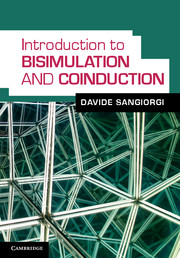Book contents
- Frontmatter
- Contents
- List of illustrations
- Preface
- General introduction
- 1 Towards bisimulation
- 2 Coinduction and the duality with induction
- 3 Algebraic properties of bisimilarity
- 4 Processes with internal activities
- 5 Other approaches to behavioural equivalences
- 6 Refinements of simulation
- 7 Basic observables
- Appendix A Solutions to selected exercises
- List of notation
- References
- Index
5 - Other approaches to behavioural equivalences
Published online by Cambridge University Press: 05 August 2012
- Frontmatter
- Contents
- List of illustrations
- Preface
- General introduction
- 1 Towards bisimulation
- 2 Coinduction and the duality with induction
- 3 Algebraic properties of bisimilarity
- 4 Processes with internal activities
- 5 Other approaches to behavioural equivalences
- 6 Refinements of simulation
- 7 Basic observables
- Appendix A Solutions to selected exercises
- List of notation
- References
- Index
Summary
In the first part of this chapter we present (yet) another characterisation of bisimilarity, namely bisimilarity as a testing equivalence. In a testing scenario two processes are equivalent if no experiment can distinguish them. An experiment on a process is set up by defining a test, that is, intuitively, a pattern of demands on the process (e.g., the ability of performing a certain sequence of actions, or the inability of performing certain actions). Depending on how the process behaves when such a test is conducted, the observer emits a verdict about the success or failure of the experiment. The experiments are means of understanding how the processes react to stimuli from the environment. A testing scenario has two important parameters.
How are observations about the behaviour of a process gathered? In other words, what can the observer conducting the experiment do on a process? For instance, is he/she allowed to observe the inability of a process to perform certain actions? Is he/she allowed to observe whether a process can immediately perform two distinct actions? Is he/she allowed to make a copy of a process? These decisions are embodied in the language for the tests.
How is the success or the failure of an experiment determined?
The choice for these parameters has an impact on the distinctions that can be made on the processes. We will set up a testing scenario whose induced equivalence is precisely bisimilarity.
- Type
- Chapter
- Information
- Introduction to Bisimulation and Coinduction , pp. 133 - 167Publisher: Cambridge University PressPrint publication year: 2011



